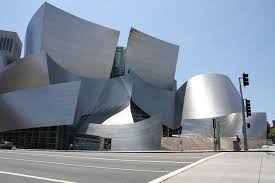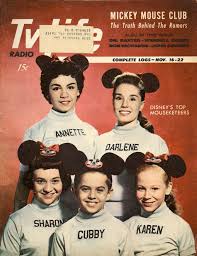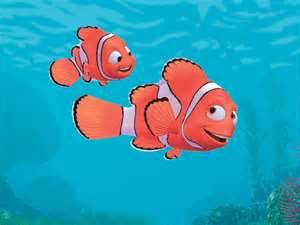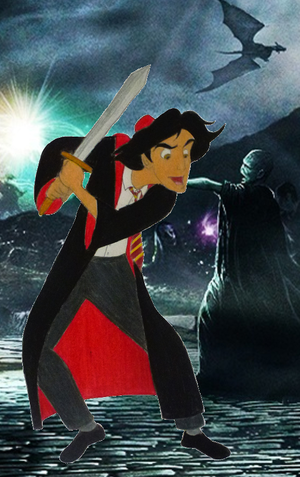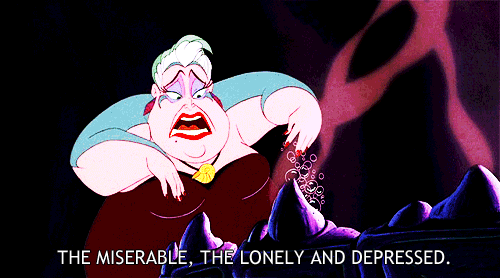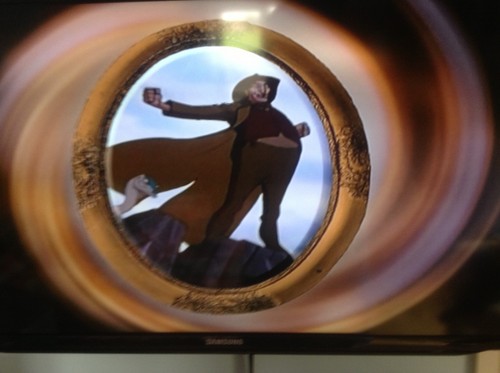Okay, the title might be misleading. I don’t intend to talk about the movie from 2011. I intend to talk about The many Adventures of Winnie the Pooh. It’s a movie with a really strange history for me, because in a way, I needed nearly 20 years to watch it fully. That’s because the movie consists of three segments which were later combined to one big movie. I had all the segments as a child on VHS (you know, those big, black things which were used before the DVD was invented), but the full movie with all segments connected and the additional last scene was never shown in theatres here in Germany. I wasn’t even aware that there was a full movie version, until Disney opened up their vaults a little bit zaidi and it was shown in TV.
Similar delayed is my history with the original book. Because for a long time I thought that the Disney version was the original one, after all, we even had the books. Yeah, this sounds strangely naïve, but in my defence, before Disney Winnie the Pooh wasn’t exactly well known in my country. Later on I got the original book as a present, but Disney’s version left an impression first.
1. The World of Winnie the Pooh
Like Peter Pan and Alice in Wonderland, Winnie the Pooh tries to delve into reality of a child, but in this case, it’s an adult who tells the child a story. This creates the unusual situation that the protagonist of the story can influence the narrator of it. At no point wewe are fooled into thinking that this might be zaidi than just a story. Sometimes it’s like wewe just have to rip a thin veil of ndoto apart to see a little boy who sits in his room au in the garden behind his house, playing with his toys. And when suddenly a new animal turns up in the hundred acre woods, wewe just know that Christophe Robin simply got a new toy. But in a way, this doesn’t make the stories less real, because it reminds the reader of the special relationship he had with his own toys.
The Disney version transfers this effect very well kwa inaonyesha the toys before diving into the book. Now, this isn’t the first movie kwa far in which the book framing device is used. It’s a Disney classic which still keeps popping up. This movie is something special, though, because it keeps reminding the audience that this is just a story. We can see the writing, the characters are walking through the book from one site to another (a lot of book shots are even referencing the original illustrations) and the narrator not only speaks to the characters, he even interferes from time to time. I can’t stress enough how creative and well done this approach is, and how perfect this transfers the tone of the book on screen.
2. The Characters
This is a simple story with very simple characters. wewe can each of them summon up with a few words. Pooh likes his honey and is not particularly smart, Piglet is afraid of everything but also truly selfless, Eeyore gloomy, Tigger boisterous, Kanga the mother and Roo the child. It’s actually never really specified what Roo’s gender is, but in my mind, I always thought female, though Disney seems to lean towards male nowadays. In the movie, the role is spoken kwa two voice actors, one male, one female, so wewe can interpret it either way.
Owl and Rabbit are somewhat special, because they are not based on stuffed wanyama but apparently real ones. Which is part of the reason, they consider themselves the smartest of the group (after all, they have brains the others have only fluff). Owl is considered especially smart because he can count to 13. And is known for telling very long-winded stories about his family. Rabbit also has a lot of “friends and family”, most of them never really specified.
Those are the only characters which got somewhat changed for the adaptation. Owl is shown as stuffed toy at the start of the movie, and while Rabbit is still prone to trying to be the leader for everyone else and much zaidi stuffy than the other wanyama are, there is no mentioning of his family.
Instead we get the gopher. And I already see the purists shuddering. Gopher is not a character from the book, he was added to give the American audience something relatable. While I don’t really follow the logic behind this (my favourite characters were always Piglet, Tigger and Roo, and I neither life in India nor in Australia), I’m not on the fence about the character. I think the way they added him was quite clever, with him constantly saying that he isn’t in the book, and the scene in which Rabbit gets angry because Gopher might give Pooh honey is funny enough that it makes the addition worthwhile.
The most important character is, in a way, Christopher Robin. But he is never really the protagonist of the stories. In the Disney version, he has the most screen-time in the first segment, because he only turns up when someone needs help.
3. The Plot
If the original novel has one fault, than that the stories are kind of meandering. Sometimes wewe get the impression that the narrator simply got bored with the story he was trying to tell and therefore ended it in the fastest possible way.
The Disney version is a little bit zaidi to the point. There is one segment about Pooh and his ongoing hunt for honey, one segment about Piglet’s fears and how he became a hero and one segment about Tigger and his upendo for jumping. For each of those segments, they connected multiple chapters from the book over one common theme. This way, the narration flows a little bit easier.
While the movie doesn’t really have a three arc structure, each segment has at least some sort of climax – and most of them are changed from the book. There Pooh isn’t hunted kwa the bees when he tries to steal their honey, when they notice him, he asks Christopher Robin to shoot a hole into his balloon so that he can reach the ground again. And he also doesn’t end up in the honey mti after getting pulled out from Rabbits door. Naturally the narrator doesn’t allow Tigger to walk over the letters when he is stuck in the tree, he is forced to go the same way down Roo took. And the hero party is only for Pooh, because the story of Piglet giving up his nyumbani happens way later in the book.
Speaking of the party: I think this is the biggest chance in the movie, and the only one I really don’t like. It always bothered me that Pooh is hailed as a hero even though he really didn’t do anything. In the book he is way zaidi proactive and does partake in piglet’s rescue.
Another thing I don’t really like is the Heffalumps and Woozles segment. Don’t get me wrong: I upendo it when Disney gets all trippy. But they should be creative doing it. Lifting zaidi than half of the segment from the pink Elephants scene in Dumbo is not creative. Most of the time, I don’t really mind if Disney reuses their own animation. It’s theirs, after all, and for all I care, they can put Bambi’s mother in every movie they make, as long as it fits. But that doesn’t mean that they have to be so obvious about it.
What I really do like though, is the ending. The whole dialogue between Christopher Robin and Pooh is lifted directly from the novel, and very, very thoughtful. What they changed though is the last sentence of the narrator. In the book he says that at this magic place there will always be a little boy playing with his bear. The movie says that no matter where Christopher Robin will go in the future, at this magic place will always be a bear, waiting for him. The latter variant is sadder, but I also think that it’s the better one. We all have to leave our childhood behind at one point, but that doesn’t mean that the childhood just vanishes.
4. Conclusion
There are people who claim that this movie destroyed the integrity of the original story. I disagree. When it comes to the franchise as a whole, yes, this tends to be a sell-out, not as bad as it could be, but it doesn’t really capture the atmosphere of the original. The movie on the other hand does. Gopher au not, ujumla, jumla it is very respectful towards the chanzo material, and even though it tells a simple story in a simple way, this is not a simple movie. In a way, this is the zaidi thoughtful predecessor of Toy Story (*ducks away while the rotten tomatoes fly*).
Don’t get me wrong: Toy Story is a good trilogy. But it is very manipulative at times, especially towards the end. And it can be a little bit over the top. Winnie the Pooh is zaidi grounded, and at the end of the day, zaidi realistic. Do we leave most of our childhood toys behind at one point? Yes, we do. Do we do it in the way Andy does it? No. Do we give up our favourite Toy, the one we own longer than we can remember, the one we carried around with us all the time? Every person I know has somewhere on a shelf a puppet au a stuffed toy, the one reminder of childhood which is just too precious to give up. The one friend, which will always wait for us.
Similar delayed is my history with the original book. Because for a long time I thought that the Disney version was the original one, after all, we even had the books. Yeah, this sounds strangely naïve, but in my defence, before Disney Winnie the Pooh wasn’t exactly well known in my country. Later on I got the original book as a present, but Disney’s version left an impression first.
1. The World of Winnie the Pooh
Like Peter Pan and Alice in Wonderland, Winnie the Pooh tries to delve into reality of a child, but in this case, it’s an adult who tells the child a story. This creates the unusual situation that the protagonist of the story can influence the narrator of it. At no point wewe are fooled into thinking that this might be zaidi than just a story. Sometimes it’s like wewe just have to rip a thin veil of ndoto apart to see a little boy who sits in his room au in the garden behind his house, playing with his toys. And when suddenly a new animal turns up in the hundred acre woods, wewe just know that Christophe Robin simply got a new toy. But in a way, this doesn’t make the stories less real, because it reminds the reader of the special relationship he had with his own toys.
The Disney version transfers this effect very well kwa inaonyesha the toys before diving into the book. Now, this isn’t the first movie kwa far in which the book framing device is used. It’s a Disney classic which still keeps popping up. This movie is something special, though, because it keeps reminding the audience that this is just a story. We can see the writing, the characters are walking through the book from one site to another (a lot of book shots are even referencing the original illustrations) and the narrator not only speaks to the characters, he even interferes from time to time. I can’t stress enough how creative and well done this approach is, and how perfect this transfers the tone of the book on screen.
2. The Characters
This is a simple story with very simple characters. wewe can each of them summon up with a few words. Pooh likes his honey and is not particularly smart, Piglet is afraid of everything but also truly selfless, Eeyore gloomy, Tigger boisterous, Kanga the mother and Roo the child. It’s actually never really specified what Roo’s gender is, but in my mind, I always thought female, though Disney seems to lean towards male nowadays. In the movie, the role is spoken kwa two voice actors, one male, one female, so wewe can interpret it either way.
Owl and Rabbit are somewhat special, because they are not based on stuffed wanyama but apparently real ones. Which is part of the reason, they consider themselves the smartest of the group (after all, they have brains the others have only fluff). Owl is considered especially smart because he can count to 13. And is known for telling very long-winded stories about his family. Rabbit also has a lot of “friends and family”, most of them never really specified.
Those are the only characters which got somewhat changed for the adaptation. Owl is shown as stuffed toy at the start of the movie, and while Rabbit is still prone to trying to be the leader for everyone else and much zaidi stuffy than the other wanyama are, there is no mentioning of his family.
Instead we get the gopher. And I already see the purists shuddering. Gopher is not a character from the book, he was added to give the American audience something relatable. While I don’t really follow the logic behind this (my favourite characters were always Piglet, Tigger and Roo, and I neither life in India nor in Australia), I’m not on the fence about the character. I think the way they added him was quite clever, with him constantly saying that he isn’t in the book, and the scene in which Rabbit gets angry because Gopher might give Pooh honey is funny enough that it makes the addition worthwhile.
The most important character is, in a way, Christopher Robin. But he is never really the protagonist of the stories. In the Disney version, he has the most screen-time in the first segment, because he only turns up when someone needs help.
3. The Plot
If the original novel has one fault, than that the stories are kind of meandering. Sometimes wewe get the impression that the narrator simply got bored with the story he was trying to tell and therefore ended it in the fastest possible way.
The Disney version is a little bit zaidi to the point. There is one segment about Pooh and his ongoing hunt for honey, one segment about Piglet’s fears and how he became a hero and one segment about Tigger and his upendo for jumping. For each of those segments, they connected multiple chapters from the book over one common theme. This way, the narration flows a little bit easier.
While the movie doesn’t really have a three arc structure, each segment has at least some sort of climax – and most of them are changed from the book. There Pooh isn’t hunted kwa the bees when he tries to steal their honey, when they notice him, he asks Christopher Robin to shoot a hole into his balloon so that he can reach the ground again. And he also doesn’t end up in the honey mti after getting pulled out from Rabbits door. Naturally the narrator doesn’t allow Tigger to walk over the letters when he is stuck in the tree, he is forced to go the same way down Roo took. And the hero party is only for Pooh, because the story of Piglet giving up his nyumbani happens way later in the book.
Speaking of the party: I think this is the biggest chance in the movie, and the only one I really don’t like. It always bothered me that Pooh is hailed as a hero even though he really didn’t do anything. In the book he is way zaidi proactive and does partake in piglet’s rescue.
Another thing I don’t really like is the Heffalumps and Woozles segment. Don’t get me wrong: I upendo it when Disney gets all trippy. But they should be creative doing it. Lifting zaidi than half of the segment from the pink Elephants scene in Dumbo is not creative. Most of the time, I don’t really mind if Disney reuses their own animation. It’s theirs, after all, and for all I care, they can put Bambi’s mother in every movie they make, as long as it fits. But that doesn’t mean that they have to be so obvious about it.
What I really do like though, is the ending. The whole dialogue between Christopher Robin and Pooh is lifted directly from the novel, and very, very thoughtful. What they changed though is the last sentence of the narrator. In the book he says that at this magic place there will always be a little boy playing with his bear. The movie says that no matter where Christopher Robin will go in the future, at this magic place will always be a bear, waiting for him. The latter variant is sadder, but I also think that it’s the better one. We all have to leave our childhood behind at one point, but that doesn’t mean that the childhood just vanishes.
4. Conclusion
There are people who claim that this movie destroyed the integrity of the original story. I disagree. When it comes to the franchise as a whole, yes, this tends to be a sell-out, not as bad as it could be, but it doesn’t really capture the atmosphere of the original. The movie on the other hand does. Gopher au not, ujumla, jumla it is very respectful towards the chanzo material, and even though it tells a simple story in a simple way, this is not a simple movie. In a way, this is the zaidi thoughtful predecessor of Toy Story (*ducks away while the rotten tomatoes fly*).
Don’t get me wrong: Toy Story is a good trilogy. But it is very manipulative at times, especially towards the end. And it can be a little bit over the top. Winnie the Pooh is zaidi grounded, and at the end of the day, zaidi realistic. Do we leave most of our childhood toys behind at one point? Yes, we do. Do we do it in the way Andy does it? No. Do we give up our favourite Toy, the one we own longer than we can remember, the one we carried around with us all the time? Every person I know has somewhere on a shelf a puppet au a stuffed toy, the one reminder of childhood which is just too precious to give up. The one friend, which will always wait for us.



